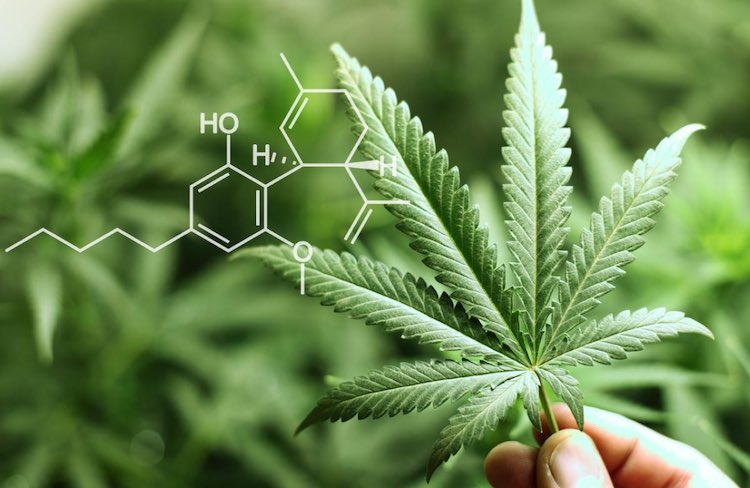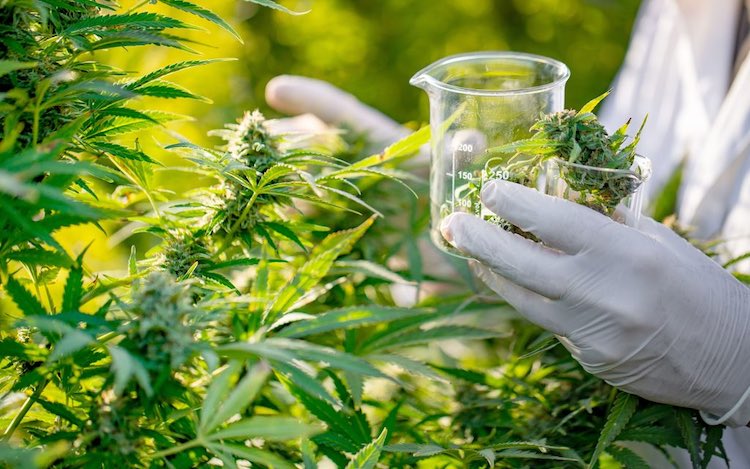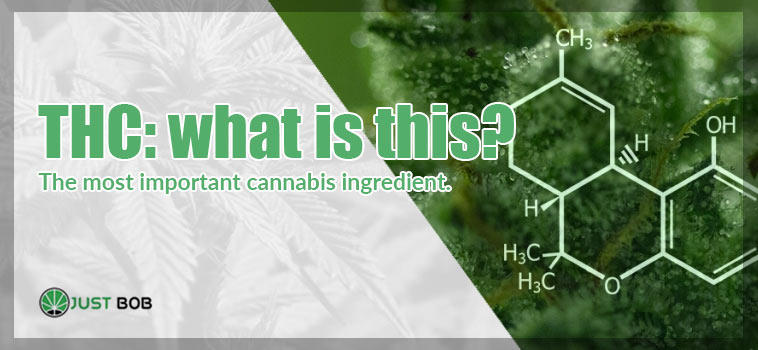THC: the most important active cannabis ingredient
The first cannabis crops date back more than 5000 years, probably in Central Asia and it is believed that it probably arrived in Europe at least in 500 B.C. No wonder then that marijuana has been used for a long time as a medicinal plant, seen and known for its many positive effects as a decrease in sensation of pain and muscle relaxation, but because of its psychogenic effects and its ability to alter consciousness too often has been used purely for recreational purposes. This was precisely the reason why, today, cannabis is at the centre of numerous ethical-moral, ideological and political debates and discussions.
WHAT THC IS FROM A BIOCHEMICAL POINT OF VIEW
Cannabis contains more than 400 natural compounds, among which cannabioids stand out, the best known of which is THC.
THC, or delta-9-tetrahydrocannabinol or more commonly called tetrahydrocannabinol, is one of the active ingredients of cannabis. It is produced from the flowers of the marijuana plant and is, in fact, a psychogenic substance with euphoric properties, but which, in the right doses and in the right way, also exerts numerous actions for the benefit of our body such as the antiemetic effect (calms the sense of nausea and vomiting).
The alterations, in a positive and negative sense on our organism, of THC can occur thanks to the presence of specific cannabinoid receptors (CB1 and CB2) present both in our nervous system and in our immune system: it is good to know and keep in mind that the human body is capable of naturally producing endogenous cannabioids such as Anandamide and Virodamine, bio-lipidic molecules capable of modulating and regulating neuronal excitability. By binding to its receptors, THC stimulates the release of dopamine from certain regions of our brain, particularly, to be more precise, by the nucleus acubens septi located in the pre-optic area of the hypothalamus.
Dopamine is a neurotransmitter that belongs to the chemical family of catecholamines and that performs many functions in our body. In particular, it acts by modulating individual behavior, mood, sleep-wake rhythm, attention, memory, voluntary movement, and much more. The binding of THC to its receptors and the consequent production and release of dopamine will mainly stimulate sensations of pleasure, concentration, pain relief, and appetite.

THE AMAZING EFFECTS OF THC
THC is a psychogenic molecule that alters a person’s consciousness and state. Obviously, the narcotic effect of tetrahydrocannabinol depends strongly on the quantities introduced into the body, as well as on the particular status of the person who consumes it: a minimum dose will simply lead to a short and not too intense state of euphoria associated with an expansion of the emotional content. It is not uncommon, in fact, cases of people who, under the effect of a classic “spinel,” begin to laugh with taste or, on the contrary, to cry with a broken heart, perhaps thinking back to a minor event that happened to them during the day. On the other hand, taking high doses of THC can have unpleasant effects on mood, which can result in depression (especially if the use is chronic in nature), or even aggression.
Another classic and usual sensation following the use of cannabis is the onset of compulsive hunger that leads subjects under the psychogenic effect of THC to swallow large amounts of food, with an absolute preference for chocolate.
In addition, some people tend to fall asleep immediately after smoking marijuana, because you should always keep in mind that THC has extremely relaxing properties, especially at the muscles and tendons levels.
THC PROS ON HEALTH
Numerous new studies on the effects of cannabis have shown that it is, in fact, a very effective treatment for patients with chronic pain, particularly that caused by the spasticity of certain diseases such as multiple sclerosis. Furthermore, THC has been shown to be a very good anti-nausea and anti-vomiting remedy to be used for all chemotherapy patients for the treatment of tumours. There is also less solid and more nuanced evidence than the previous ones that THC helps to fight weight loss and improve appetite, particularly with regard to people with AIDS. It also seems to be an excellent aid in alleviating the symptoms of Tourette’s syndrome, a neurological disease characterized by the presence of inconstant, sometimes fleeting and sometimes chronic motor tics and phonators, the severity of which can range from extremely mild to disabling. THC, thanks to its many relaxing and calming properties, is also effective against anxiety disorder.
On the other hand, considering the possible negative effects, it must be said that this is less dangerous than other drugs: there is no evidence of any death from cannabis overdoses! But one must bear in mind that it is still a drug and that it is not even as harmless as many would have us believe.
…AND THE OTHER SIDE
First of all, chronic and long-standing marijuana buyers have a higher risk of getting sick with bronchitis and other respiratory system diseases. Moreover, since cannabis consumption is very often combined with tobacco consumption, it is also necessary to consider all the contraindications of smoking, including the onset of lung cancer, but which can affect any organ of the human body.
The risk of chronic cannabis use for pregnant women is to give birth with a higher probability to children with lower birthweight.
Other important risks that should not be underestimated for regular users are the higher chances of suffering from diseases such as schizophrenia and psychosis, as THC acts precisely at the level of the nervous system and if concentrations are high and chronic, in the long run, they could permanently damage neurons.
THE EUROPEAN LAW ON LEGAL CANNABIS AND THE LIMIT OF THC
The hemp certified for legal agricultural use by the European Union is supported by the laws:
- The European Delegated Regulation n. 639/2014 on production of hemp.
- The European Regulation n. 1307/2013 on hemp cultivation in crops.
In Italy, however, CBD flowers are completely legal only if the cannabis has a THC content not exceeding 0.2%. It can also be grown in a garden and then be resold to traders or companies, being careful to comply with the directives of the law. In addition, the Hemp Law of 2 December 2016, n. 242 prohibits imports not included in the European catalogue, thus avoiding Swiss weed, crossbreeds, and hybrids.
In Europe, cannabis seeds are sold as collectable items therefore you can buy weed seeds on line but only for that purpose.
CBD WEED: USES PERMITTED BY LAW
The European law provides for the use of CBD cannabis for industrial use such as for the production of many food products, such as CBD oils, bread, pasta or even biscuits, going to exploit the seeds that are collected from the plant.
Another use of cannabis can be in textiles: cannabis fibres, being particularly resistant, can also be used for the production of clothes, curtains or fabrics. The last field of use envisaged by the recent Italian legislature is that of bio-building, thanks to its multiple insulating properties.
It should also be specified that legal hash, and legal weed although have a very low THC content, could make drug tests positive: it is therefore not recommended to drive after smoking CBD buds.
MEDICAL CANNABIS

A completely different discourse must be pursued if we are to talk about medical cannabis that is used only for pharmaceutical purposes. First of all, this is cultivated and produced by specialized bodies and with detailed techniques. In particular, medical cannabis is grown in GACP (Good Agriculture and Collection Practice) and GMP (Good Manufacturing Practice) using cloning techniques, in specially indoor greenhouses and with the germination method reported in DM 9/11/15, as well as in fields specifically authorized by the Ministry of Health. It may or may not contain THC or even be standardised in the content of certain cannabinoids (e.g. THC, CBD, CBN). This type of cannabis can be purchased only and exclusively in a pharmacy and upon special and appropriate medical request. Moreover, unlike legal weed, medical cannabis has to meet several other criteria:
- It must be almost completely sterile and not contaminated by bacteria: it must have values below 10 CFU (Colony Forming Units),
- Must contain low amounts of heavy metals: have values below certain ppm (Parts Per Million). It should be borne in mind that cannabis is to be considered a sponge plant, i.e. its roots are capable of absorbing heavy metals and other polluting products from the soil that are mainly concentrated in the influences;
- It must have a very low content of alflatoxins to ensure the health safety of those who use it. Aflatoxins are mycotoxins produced by fungal species and other highly toxic moulds and are among the most carcinogenic substances in existence.
LEGAL CANNABIS: LOW THC AND HIGH CBD
As already mentioned, THC is not the only active substance contained in cannabis. Among the various active ingredients, CBD, commonly called cannabinol, must also be noticed. Although both molecules have a similar chemical composition, they differ significantly: CBD, first of all, reduces the psychogenic effects of THC, and also reduces anxiety, promotes sleep and has a relaxing effect on the human body. Thus, cannabinol has no effect on mood, consciousness, and mental faculties, as THC does. Other positive effects of CDB include its anti-inflammatory, anti-oxidant, and anti-depressant properties, and it also seems to act as a tumour antigen.
The two natural cannabinoids can be combined in different ways in different sizes:
- High THC levels and low CBD levels: will give as a final effect what some people call “high,” i.e., psychoactive reactions with amplification of personal emotions;
- Same levels of THC and CBD: will provide greater benefits for medical users with a substantial decrease in the side effects given by the action of THC;
- High CBD levels and low THC levels: will provide greater benefits for medical users with a substantial decrease in the side effects of THC action;



